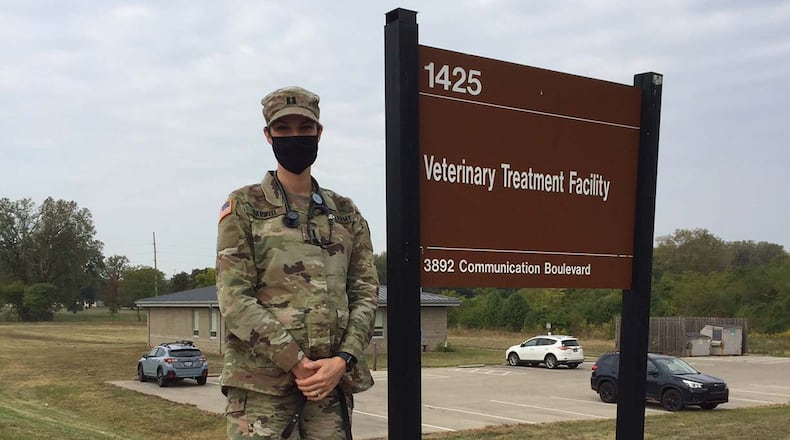After all, Capt. (Dr.) Casey Barwell owns a retired MWD, Suzy, a 12-year-old all-black German Shepherd who retired from Malmstrom AFB, Montana, and is specialized in drug detection and patrol.
Barwell has been stationed at Wright-Patterson since July, changing from Ellsworth AFB, South Dakota. A member of the Army Veterinary Corps, she and other personnel at the Veterinary Facility offer many types of routine care services for the privately owned, companion animals of military families eligible to receive care. Active-duty, retirees with full benefits, Guard and reservists are eligible to bring their animals for care.
The facility, located at Bldg. 1425, Area A, just off Communications Boulevard near Gate 15A, does more than provide almost all facets of care of the installation’s MWDs, plus working dogs with U.S. Customs and Border Patrol and the Transportation Security Administration.
As a Tier II facility, Wright-Patterson AFB’s facility has a military veterinarian, civilian veterinarian, two military animal care specialists and two civilian animal health assistants, when fully staffed.
The staff has instituted a number of precautions to maintain the health and safety of both clients and staff.
“We are providing curbside service at this time,” Barwell said. "We have the client call the clinic at their appointment time, then a veterinary technician goes to their vehicle, collects the dog or cat and gets its history, then takes it into the facility for treatment. We do the exam and any necessary procedures without the owner present, then call the owner to hold a discussion with them, accept payment over the phone, then return the animal.
“We are minimizing physical contact as much as possible,” she said.
The COVID-19 pandemic, causing personal protective equipment shortages, has temporarily eliminated some services offered, such as dental cleanings and surgical services like spays or neuters and mass removals.
X-rays, laboratory tests, blood workups, allergy treatment, vaccinations, nail trims, microchipping and preventative medications for heartworms, fleas and ticks are still available. Often pricing is less than at civilian veterinary care facilities. Potential customers are welcome to call the clinic for a “ballpark” quote.
Prescriptions may be requested over the phone, then picked up through a box outside the front door, Barwell said.
Scheduling differs due to the pandemic-related safety precautions, with fewer appointments available. Appointments take longer, too – up to an hour per a family’s pet or pets, she said. Priority appointments include those for overdue rabies and puppies for deworming and more.
“Those are zoonotic diseases that must be treated for public health reasons,” Barwell noted.
Sick call appointments are being accepted but many are referred off-base due to time restrictions. U.S. Department of Agriculture health certificate appointments are accepted because so many people have had last-minute changes for permanent changes of station and overseas assignments.
“We’ve been trying to accept the health certificate appointments as much as possible,” she said, “because that is a service we are able to offer that many civilian offices in the area might not be capable of.”
Military dogs are welcome patients
A benefit of the clinic is it sharpens the veterinarians' and staff’s medical and surgical skills to sustain their main mission of caring for military working dogs.
Not surprising is that the military working dogs are the best-behaved patients the veterinarians treat.
Their care has not been affected at all by the pandemic.
“If they need us, we are there for them of course,” she said.
A large, color-coded whiteboard grid opposite the vets' shared office helps keep track of the working dogs' medical readiness and needs and their handlers. The prominent visual aid indicates the scope of the clinic’s top mission.
The MWDs' activity levels, immunizations records, weight and diet as aspects of overall health are carefully monitored, with handlers' comments respectfully considered.
Many different responsibilities
A native of Westerville, Ohio, Barwell graduated from the Ohio State University College of Veterinary Medicine after majoring in biology at Indiana University, where she was involved in the ROTC program.
“Being a military veterinarian comes with a lot of different responsibilities,” she said. "As we discussed, we wear many ‘hats’ – clinician, food inspector, practice manager, Army officer/mentor, and most importantly, Soldier.
“It can be a lot to manage, and every assignment brings different proportions of these responsibilities. But that being said, the variability in my career is one of the things I love about it most,” Barwell said. “It helps keep me engaged and helps me grow as leader. My job allows me to help a lot of people. Whether that is through training human providers on how to care for MWDs during deployments where veterinarians are sparse, developing young soldiers on life skills, ensuring the food in our commissaries is safe to eat, or caring for our servicemembers'/retirees' pets. The Veterinary Corps may not be a very large, but our impact is great!”
To locate a military veterinary treatment facility anywhere in the world, go online to https://phc.amedd.army.mil/topics/animed/vtfo/Pages/Veterinary-Treatment-Facility-Interactive-Map.aspx.
Wright-Patterson Air Force Base Veterinary Treatment Facility
- Bldg. 1425, Area A
- Available to: Active-duty military, retirees with full benefits, Guard and reservists
- Hours: Monday through Friday, 8 a.m. to 4 p.m., open on some Air Force Materiel Command Family Days
- 937-257-6853
- Facebook: Wright-Patterson Veterinary Treatment Facility, for updates, closures, seasonal pet facts and tips
About the Author
